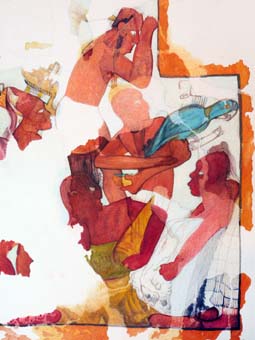
Researchers from the University of València (UV) and the Universitat Politècnica de València (UPV) have presented the results on Thursday of a new archaeological find they have done in the Mayan city of Chilonché, where they have discovered the first Mayan fresco found so far in Guatemala. The work has been led by Professors Cristina Vidal (UV) and Gaspar Muñoz (UPV).
This is a finding of particular relevance due to it is the first mural of its kind to be found in this archaeological region, and the unquestionable value of his paintings "by the information it provides, both historical and artistic, for the pictorial technique they can be considered exceptional", according to the researchers.
The finding was made by the same Spanish-Guatemalan interdisciplinary team in 2009 achieved another important finding - great Mayan "mascarón" over 2.000 years old, which was located in the same stunning Acropolis of Chilonché, 15 meters high, where they have recently found these spectacular wall paintings, dating from the VIII century AD, have been determined in accordance with the first data obtained after its discovery.
The mural was located within a quarter of one of the buildings -a Mayan palace built in the Late Classic period (600-900 AD), part of the monuments of the Acropolis of Chilonché, which for centuries had remained buried in the jungle to be discovered by this group of researchers. This room was closed intentionally with stones and soil by ancient Mayans, and as a result the paintings have been preserved in good condition.
In the paintings found by the researchers, it can be seen several scenes that recreate a historical event where offerings were made to a special character. They show figurative figures with male and female characters in different poses and sizes, painted in black, red and ochre, as well as hieroglyphic signs mentioning their names. Deciphering these hieroglyphics has allowed get much deeper into the dynastic history of the various cities, wars that kept each other, or their diplomatic relations, while other times these texts refer to their gods and religious beliefs, according to a finding after a direct and detailed study by a epigraphist specialist in Mayan writing, Professor Alfonso Lacadena of Complutense University of Madrid. The interpretation of texts that decorate the paintings help better understand the Mayan society who settled in this archaeological site.
All this makes the paintings discovered in Chilonché constitute an outstanding and highly relevant findings, as much the virtual absence of murals preserved of the classical period, as the interest that covers the study of the characters and their accompanying texts, according to the responsible for the project, which began in 2009. Furthermore, it has received in the last archaeological campaign (2012-2013), financial support from the Dutch Foundation Prince Claus, and funded development cooperation through the Program 0.7 of the University of Valencia, as well as a grant from Spanish Ministry of Education, Culture and Sports which have given financial support to this project, by which have been rescued these spectacular wall paintings, which were in danger of disappearing because of looting.
The work of this major finding has been led by Professors Gaspar Muñoz (UPV) and Cristina Vidal (UV), directors of the archaeological project La Blanca, an inter-university project that involved the University of Valencia, Universitat Politècnica de València and University of San Carlos of Guatemala, and in which the members of this project have done archaeological excavations and various actions for setting the value of their cultural heritage since 2004. A nine-year work has paid off, and so was recognized this year 2013 with the award 'Best practices in site conservation', awarded by the prestigious Archaeological Institute of America (AIA), for the work developed in La Blanca.
Rescue operation
Given the importance of the find, and once the rescue intervention, documentation and restoration of wall paintings is done, researchers consider necessary to launch a project to safeguard not only these paintings but also those which are expected within other of the rooms that make up this Mayan palace. Indeed, in other rooms of the same building have also found remains of wall paintings but by the fact of having been exposed to the elements they have largely disappeared.
However, researchers do not rule out that new discoveries are made in these unexplored areas of the region where it could be kept more hidden treasures of the Mayan culture. All this shows the artistic and cultural importance of this archaeological site.
Last update: 12 de december de 2013 13:53.
News release


















